Biological Organic Fertilizer Market Size
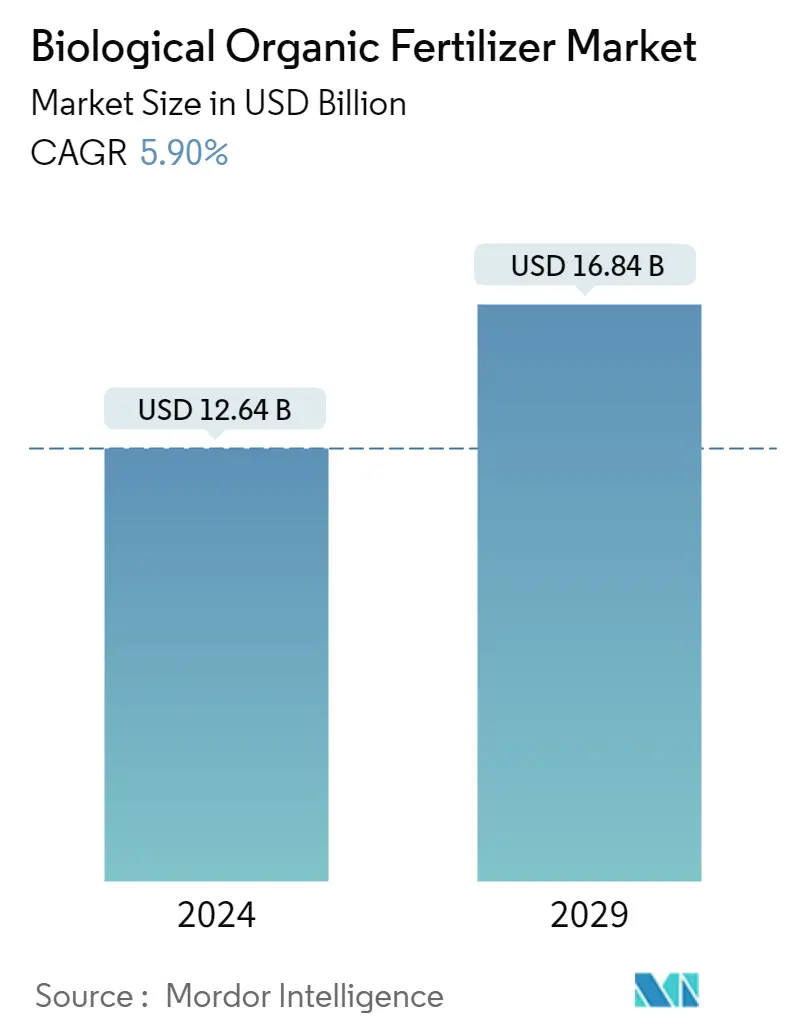
| Study Period | 2019 - 2029 |
| Market Size (2024) | USD 12.64 Billion |
| Market Size (2029) | USD 16.84 Billion |
| CAGR (2024 - 2029) | 5.90 % |
| Fastest Growing Market | Asia Pacific |
| Largest Market | North America |
Major Players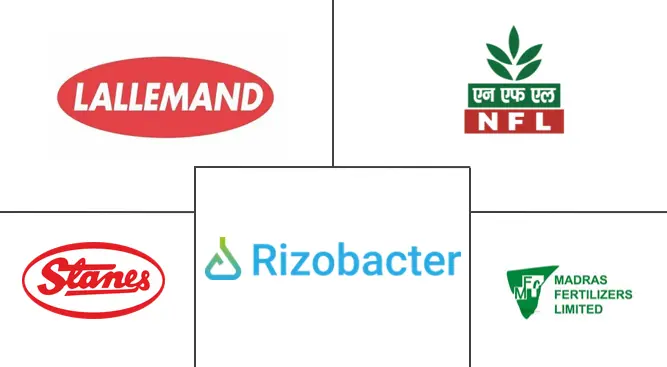
*Disclaimer: Major Players sorted in no particular order |
Biological Organic Fertilizer Market Analysis
The Biological Organic Fertilizer Market size is estimated at USD 12.64 billion in 2024, and is expected to reach USD 16.84 billion by 2029, growing at a CAGR of 5.90% during the forecast period (2024-2029).
- The increased practice of organic farming is one of the significant factors behind the growth of the biological organic fertilizer market. The emphasis on sustainable agriculture and government support to the manufacturers are the other factors that augment the development of the market.
- Moreover, recent studies have shown the effect of bio-organic fertilizers on grains. Bio-organic fertilizer that exhibited various qualities, such as nutrient acquisition and plant growth promotion of rice, is an organic-based biofertilizer that contains RP (5%), biochar (15%), and the living cells of Plant Growth Promoting Bacteria (PGPB), mostly Bacillus, Proteus, and Paenibacillus spp., which were isolated from the floodplain, terrace, and saline soils. The results of 16 field experiments and 18 farmers' demonstration trials undertaken by Bangladesh Rice proved that added PGPB supplemented the 30% synthetic N requirement of rice production through biological nitrogen fixation and fully complemented available P from rock phosphate by solubilization during the plant growth period. The combined effect of living ingredients and organic matter of the bio-organic fertilizer saved 30% urea-N, eliminated 100% Triple Super Phosphate fertilizer use in rice production, and simultaneously improved nutrient uptake, N, P use efficiencies, rice yield, and soil health, eventually enhancing the adoption of biological organic fertilizers.
Biological Organic Fertilizer Market Trends
This section covers the major market trends shaping the Biological Organic Fertilizer Market according to our research experts:
Increasing Organic Farming
The rising popularity of organic products and consumption has forced the expansion of organic farming across the globe. Subsequently, the market for biological organic fertilizers has grown dramatically in response to the recent surge in interest in regenerative agriculture, organic farming, and soil health. Natural organic fertilizers contain specific levels of microorganisms (such as nitrogen-fixing bacteria); organic fertilizers similarly contain microorganisms and typically come from animals and plants, such as livestock manure and crop residues, which are highly suitable for Organic Farming.
According to the Research Institute of Organic Agriculture, the area under organic farming increased by 4.1% in 2020. In addition, the regional statistics of both developed and developing countries have depicted the growth of organic agriculture in the country. For instance, according to the statistics by the government of India, the area under the organic farming certification process in India has almost doubled in 2021-2022, indicating the increasing initiatives and adoption of organic farming, with the full production accounting for 20,540.63 metric tons. Thus, owing to the rising organic area under cultivation and the increasing demand for good-quality crops, cultivators are anticipated to use biological organic fertilizers instead of excessive synthetic fertilizers, driving the market.
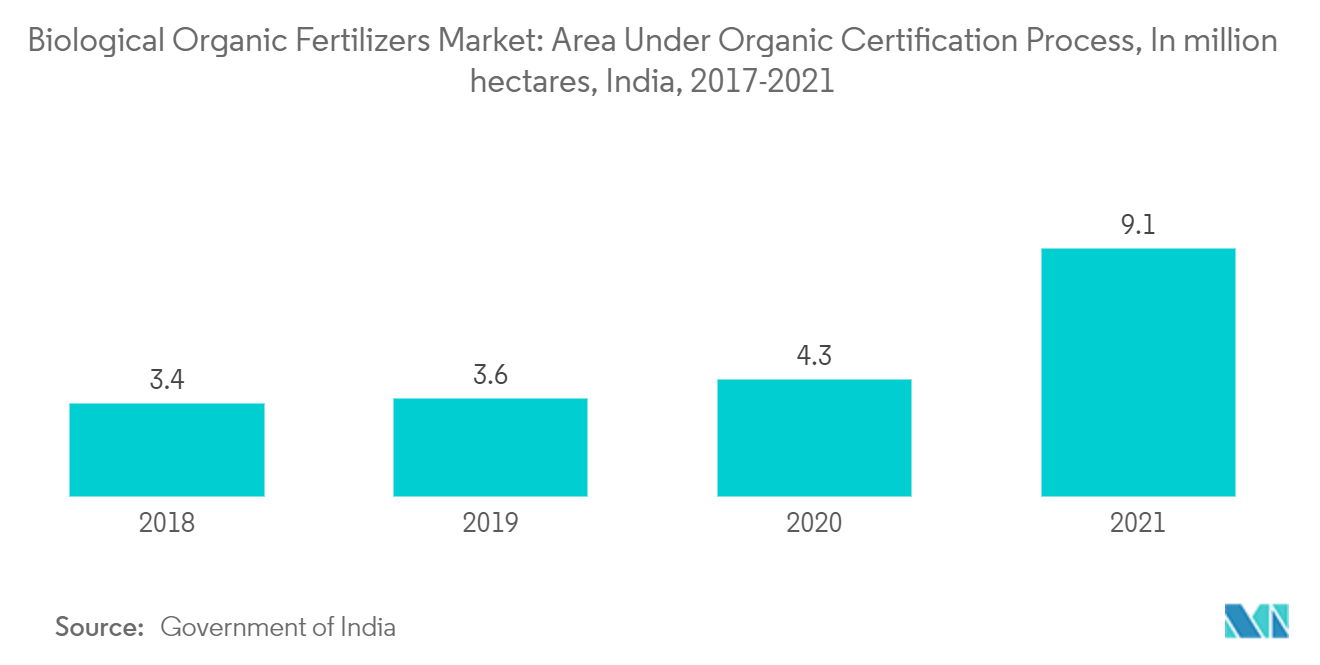
Asia Pacific is the fastest growing market
The organic fertilizer market in Asia-Pacific is the fastest-growing among all the other regions. The consumption of organic fertilizers in Asia-Pacific is anticipated to increase with rising awareness among farmers about the benefits of bio-based and organic residue-based fertilizers. The regional demand is concentrated among major agriculture-based countries like China, India, Thailand, Indonesia, and Vietnam while China and India are leading the market developments.
In addition, not only do different countries in the region have their own regulations for fertilizers in general, but they also often have specific requirements and rules for biological and organic fertilizers. For instance, the Regulation of the MOA No. 1/2019 concerning the Registration of Organic Fertilizers, Biological Fertilizers, and Soil Improvement in Indonesia aims to ensure the quality of fertilizer products circulating in the market by requiring them to pass a quality test by an MOA-approved institution.
Further, the growing organic farming in different countries under the region and the increasing demand for organic products drive the market in the region. Moreover, there have been major policy developments related to the organic sector in some Asian countries. In Japan, there was a major development in the Basic Plan for Agriculture and Management, aiming to triple the number of organic farmers and organic land by 2030, in turn boosting the growth of the market.
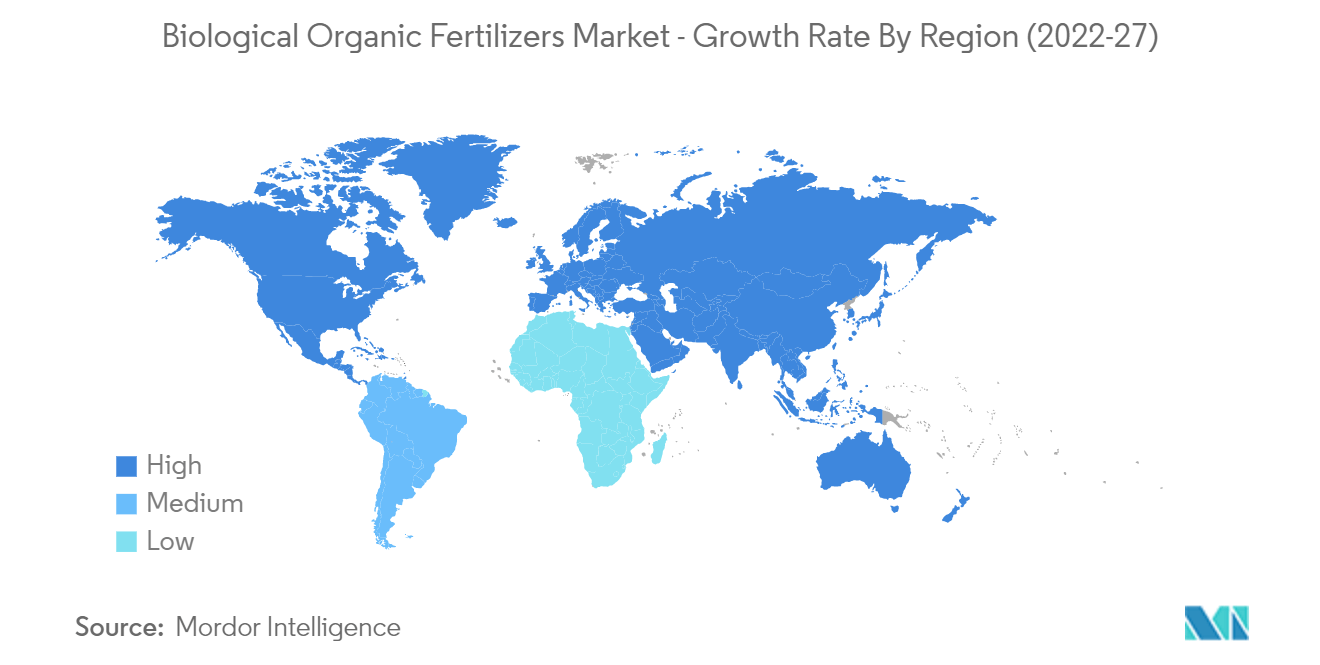
Biological Organic Fertilizer Industry Overview
The Biological organic fertilizer market is fragmented due to prominent international and regional players. Collaborations with government organizations and expansion in the market, along with product innovation, are some of the strategies adopted by the companies. Rizobacter Argentina S.A, Lallemand, and National Fertilizers Limited are some of the leading market players in the biological organic fertilizer market. The unregulated scenario in the market has sustained the small companies, making the market fragmented, which could be converted to a consolidated one with the proper regulations shortly.
Biological Organic Fertilizer Market Leaders
-
Rizobacter Argentina S.A
-
Lallemand Inc.
-
National Fertilizers Limited
-
T Stanes & Company Limited
-
Madras Fertilizers Limited
*Disclaimer: Major Players sorted in no particular order
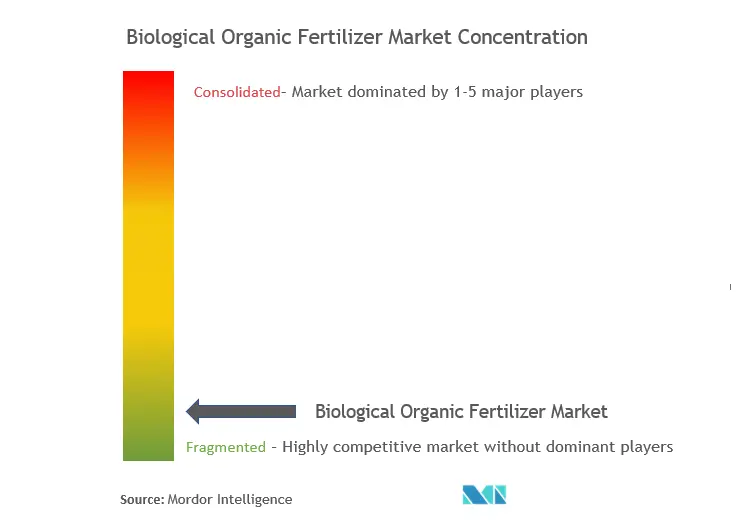
Biological Organic Fertilizer Market News
- October 2022: ACI Biolife Fertilizer and the Bangladesh Institute of Nuclear Agriculture (BINA) signed an MoU for Biofertilizer, i.e., Trichoderma development and testing. ACI Fertilizer is developing a Biofertilizer Lab at Jhikorgacha, Jessore, with support from BINA.
- September 2022: Corteva Agriscience acquired Symborg, an expert in microbiological technologies based in Murcia, Spain. Acquiring Symborg is a significant next step in Corteva's strategy to accelerate the development of a best-in-class biological portfolio as a valuable part of the integrated solutions.
- March 2022: Rizobacter expanded and commercialized its products to other African countries apart from South Africa, including Malawi, Zambia, Nigeria, Ghana, Uganda, Kenya, Sierra Leone, and Tanzania.
Biological Organic Fertilizer Market Report - Table of Contents
1. INTRODUCTION
- 1.1 Study Assumptions and Market Definition
- 1.2 Scope of the Study
2. RESEARCH METHODOLOGY
3. EXECUTIVE SUMMARY
4. MARKET DYNAMICS
- 4.1 Market Overview
- 4.2 Market Drivers
- 4.3 Market Restraints
-
4.4 Porter's Five Force Analysis
- 4.4.1 Bargaining Power of Suppliers
- 4.4.2 Bargaining Power of Buyers/Consumers
- 4.4.3 Threat of New Entrants
- 4.4.4 Threat of Substitute Products
- 4.4.5 Intensity of Competitive Rivalry
5. MARKET SEGMENTATION
-
5.1 Type
- 5.1.1 Microorganism
- 5.1.1.1 Rhizobium
- 5.1.1.2 Azotobacter
- 5.1.1.3 Azospirillum
- 5.1.1.4 Blue-green Algae
- 5.1.1.5 Phosphate Solubilizing Bacteria
- 5.1.1.6 Mycorrhiza
- 5.1.1.7 Other Microorganisms
- 5.1.2 Organic residues
- 5.1.2.1 Green Manure
- 5.1.2.2 Fish Meal
- 5.1.2.3 Bone Meal
- 5.1.2.4 Oil Cakes
- 5.1.2.5 Others
-
5.2 Application
- 5.2.1 Grains and Cereals
- 5.2.2 Pulses and Oilseeds
- 5.2.3 Fruits and Vegetables
- 5.2.4 Commercial Crops
- 5.2.5 Turf and Ornamentals
-
5.3 Geography
- 5.3.1 North America
- 5.3.1.1 United States
- 5.3.1.2 Canada
- 5.3.1.3 Mexico
- 5.3.1.4 Rest of North America
- 5.3.2 Europe
- 5.3.2.1 Germany
- 5.3.2.2 United Kingdom
- 5.3.2.3 France
- 5.3.2.4 Spain
- 5.3.2.5 Italy
- 5.3.2.6 Russia
- 5.3.2.7 Rest of Europe
- 5.3.3 Asia Pacific
- 5.3.3.1 China
- 5.3.3.2 Japan
- 5.3.3.3 India
- 5.3.3.4 Australia
- 5.3.3.5 Rest of Asia-Pacific
- 5.3.4 South America
- 5.3.4.1 Brazil
- 5.3.4.2 Argentina
- 5.3.4.3 Rest of South America
- 5.3.5 Africa
- 5.3.5.1 South Africa
- 5.3.5.2 Rest of Africa
6. COMPETITIVE LANDSCAPE
- 6.1 Most Adopted Competitor Strategies
- 6.2 Market Share Analysis
-
6.3 Company Profiles
- 6.3.1 Rizobacter Argentina S.A.
- 6.3.2 Lallemand Inc.
- 6.3.3 National Fertilizers Limited
- 6.3.4 Madras Fertilizers Limited
- 6.3.5 T Stanes & Company Limited
- 6.3.6 Gujarat State Fertilizers & Chemicals Ltd
- 6.3.7 String Bio
- 6.3.8 Rashtriya Chemicals & Fertilizers Ltd
- 6.3.9 Agrinos
- 6.3.10 Biomax Naturals
- 6.3.11 Symborg (Corteva Agriscience)
- 6.3.12 Agri Life
- 6.3.13 Premier Tech
- 6.3.14 Biofosfatos do Brasil
- 6.3.15 Kiwa Bio-Tech Products Group Corporation
- 6.3.16 Protan AG
- 6.3.17 Mapleton Agri Biotech Pty Limited
- 6.3.18 Bio Nature Technology PTE Ltd.
- 6.3.19 Kribhco
- 6.3.20 Bio Ark Pte Ltd
- 6.3.21 Novozymes
- 6.3.22 Savio BIO Organic AND Fertilizers Private Limited
- 6.3.23 ACI Biolife
- *List Not Exhaustive
7. MARKET OPPORTUNITIES AND FUTURE TRENDS
** Subject To AvailablityBiological Organic Fertilizer Industry Segmentation
Biological Organic Fertilizers refer to a type of fertilizer that combines microbial and organic fertilizer benefits. These fertilizers are primarily made from animal and plant residues combined with inert organic and decaying materials. In other words, Biological Organic Fertilizer is a processed inoculated compost from any organic material that has undergone rapid decomposition by introducing homogeneous microbial inoculants. The biological organic fertilizers market is segmented by Type (Microorganism and Organic residues), Application (Grains and Cereals, Pulses and Oilseeds, Fruits and Vegetables, Commercial Crops, and Turf and Ornamentals), and Geography into (North America, Europe, Asia-Pacific, South America, and Africa). The report offers market size and forecasts in terms of value in USD million.
| Type | Microorganism | Rhizobium |
| Azotobacter | ||
| Azospirillum | ||
| Blue-green Algae | ||
| Phosphate Solubilizing Bacteria | ||
| Mycorrhiza | ||
| Other Microorganisms | ||
| Type | Organic residues | Green Manure |
| Fish Meal | ||
| Bone Meal | ||
| Oil Cakes | ||
| Others | ||
| Application | Grains and Cereals | |
| Pulses and Oilseeds | ||
| Fruits and Vegetables | ||
| Commercial Crops | ||
| Turf and Ornamentals | ||
| Geography | North America | United States |
| Canada | ||
| Mexico | ||
| Rest of North America | ||
| Geography | Europe | Germany |
| United Kingdom | ||
| France | ||
| Spain | ||
| Italy | ||
| Russia | ||
| Rest of Europe | ||
| Geography | Asia Pacific | China |
| Japan | ||
| India | ||
| Australia | ||
| Rest of Asia-Pacific | ||
| Geography | South America | Brazil |
| Argentina | ||
| Rest of South America | ||
| Geography | Africa | South Africa |
| Rest of Africa |
Biological Organic Fertilizer Market Research FAQs
How big is the Biological Organic Fertilizer Market?
The Biological Organic Fertilizer Market size is expected to reach USD 12.64 billion in 2024 and grow at a CAGR of 5.90% to reach USD 16.84 billion by 2029.
What is the current Biological Organic Fertilizer Market size?
In 2024, the Biological Organic Fertilizer Market size is expected to reach USD 12.64 billion.
Who are the key players in Biological Organic Fertilizer Market?
Rizobacter Argentina S.A, Lallemand Inc., National Fertilizers Limited, T Stanes & Company Limited and Madras Fertilizers Limited are the major companies operating in the Biological Organic Fertilizer Market.
Which is the fastest growing region in Biological Organic Fertilizer Market?
Asia Pacific is estimated to grow at the highest CAGR over the forecast period (2024-2029).
Which region has the biggest share in Biological Organic Fertilizer Market?
In 2024, the North America accounts for the largest market share in Biological Organic Fertilizer Market.
What years does this Biological Organic Fertilizer Market cover, and what was the market size in 2023?
In 2023, the Biological Organic Fertilizer Market size was estimated at USD 11.94 billion. The report covers the Biological Organic Fertilizer Market historical market size for years: 2019, 2020, 2021, 2022 and 2023. The report also forecasts the Biological Organic Fertilizer Market size for years: 2024, 2025, 2026, 2027, 2028 and 2029.
Organic Fertilizer Industry Report
Statistics for the 2024 Organic Fertilizer market share, size and revenue growth rate, created by Mordor Intelligence™ Industry Reports. Organic Fertilizer analysis includes a market forecast outlook to 2029 and historical overview. Get a sample of this industry analysis as a free report PDF download.



